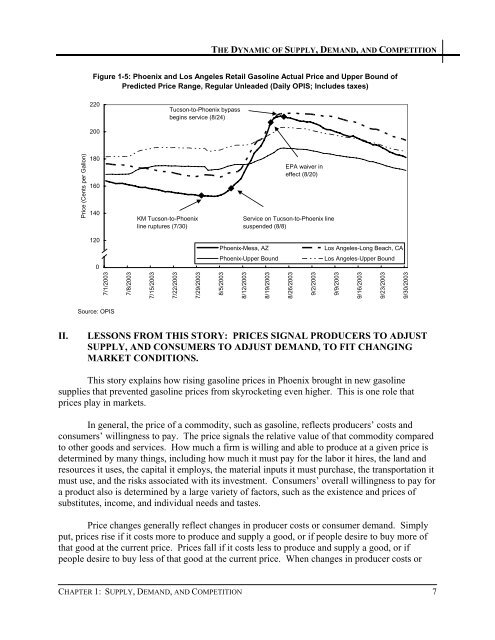Gasoline Price Changes - Federal Trade Commission
Gasoline Price Changes - Federal Trade Commission
Gasoline Price Changes - Federal Trade Commission
You also want an ePaper? Increase the reach of your titles
YUMPU automatically turns print PDFs into web optimized ePapers that Google loves.
<strong>Price</strong> (Cents per Gallon)<br />
220<br />
200<br />
180<br />
160<br />
140<br />
120<br />
100 0<br />
7/1/2003<br />
7/8/2003<br />
7/15/2003<br />
7/22/2003<br />
7/29/2003<br />
THE DYNAMIC OF SUPPLY, DEMAND, AND COMPETITION<br />
Figure 1-5: Phoenix and Los Angeles Retail <strong>Gasoline</strong> Actual <strong>Price</strong> and Upper Bound of<br />
Predicted <strong>Price</strong> Range, Regular Unleaded (Daily OPIS; Includes taxes)<br />
Source: OPIS<br />
KM Tucson-to-Phoenix<br />
line ruptures (7/30)<br />
Tucson-to-Phoenix bypass<br />
begins service (8/24)<br />
8/5/2003<br />
8/12/2003<br />
8/19/2003<br />
EPA waiver in<br />
effect (8/20)<br />
Service on Tucson-to-Phoenix line<br />
suspended (8/8)<br />
Phoenix-Mesa, AZ Los Angeles-Long Beach, CA<br />
Phoenix-Upper Bound Los Angeles-Upper Bound<br />
II. LESSONS FROM THIS STORY: PRICES SIGNAL PRODUCERS TO ADJUST<br />
SUPPLY, AND CONSUMERS TO ADJUST DEMAND, TO FIT CHANGING<br />
MARKET CONDITIONS.<br />
This story explains how rising gasoline prices in Phoenix brought in new gasoline<br />
supplies that prevented gasoline prices from skyrocketing even higher. This is one role that<br />
prices play in markets.<br />
In general, the price of a commodity, such as gasoline, reflects producers’ costs and<br />
consumers’ willingness to pay. The price signals the relative value of that commodity compared<br />
to other goods and services. How much a firm is willing and able to produce at a given price is<br />
determined by many things, including how much it must pay for the labor it hires, the land and<br />
resources it uses, the capital it employs, the material inputs it must purchase, the transportation it<br />
must use, and the risks associated with its investment. Consumers’ overall willingness to pay for<br />
a product also is determined by a large variety of factors, such as the existence and prices of<br />
substitutes, income, and individual needs and tastes.<br />
<strong>Price</strong> changes generally reflect changes in producer costs or consumer demand. Simply<br />
put, prices rise if it costs more to produce and supply a good, or if people desire to buy more of<br />
that good at the current price. <strong>Price</strong>s fall if it costs less to produce and supply a good, or if<br />
people desire to buy less of that good at the current price. When changes in producer costs or<br />
CHAPTER 1: SUPPLY, DEMAND, AND COMPETITION 7<br />
8/26/2003<br />
9/2/2003<br />
9/9/2003<br />
9/16/2003<br />
9/23/2003<br />
9/30/2003
















